USB chargers and USB power banks have several different electrical ratings on them, and it’s important that we know what they all mean. There are power input ratings, energy storage capacity ratings, charge rates, frequencies and more.
USB Power Bank Ratings
A USB power bank is a USB charger with a battery built into it. The battery in devices is what supplies your phone with power. You also use a USB charger to recharge power banks, in most cases (check to see if the ‘input’ plug for the power bank is a micro-USB port, that’s usually it). A standard USB power bank will supply your phone with current at 5 Volts. Some fast chargers might operate at higher voltages.
The three ratings that you should be most concerned about with a USB power bank are:
- mAh: Energy storage capacity. This will give you an idea of how many times the power bank can recharge your phone. If your phone battery is 4,000 mAh and your power bank is 4,000 mAh, then you can get up to one recharge out of it. You will then have to recharge the power bank itself afterwards. The ‘h‘ is key because it refers to energy stored in the power bank’s battery. The ‘h‘ means hours and ‘mAh‘ means milliamp-hours.
- A (for example: 2.4A): This refers to Amps. 1 Amp – 1,000 mA. This is the maximum rate at which the power bank can charge your phone. This helps you gauge how fast it can recharge your phone. Your phone may limit the rate, so it won’t necessarily charge at 2 Amps. A higher number is better in this case.
- Input power for the power bank (often 1A): A power bank requires a certain amount of power to recharge itself. This is something that you usually don’t have to worry about, because it is well within the limitations of most USB chargers.
USB Charger Ratings
If you’re shopping for a ‘wall wart’ USB charger, then it will have several ratings on it that look something like this:
- Input: 120V AC. This powers the charger itself.
- 50-60 Hz: The frequency of your power grid.
- Input 0.5A: This powers the charger itself.
- Output: 5V 2A: This is what the charger supplies to your phone.
- Output: 9V 1.67 Amps: This is for a Samsung Adaptive fast charger. This is not a conventional USB charger.









